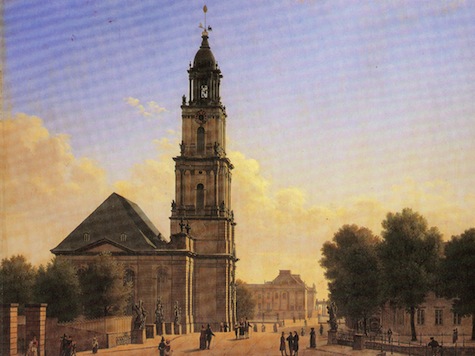For the moment, efforts to halt the reconstruction of the Garrison Church in Potsdam, scene of a pivotal moment in Hitler’s rise to power, have failed.
On Wednesday afternoon, the Potsdam city parliament rejected a referendum which would have transferred decision-making control over the reconstruction to the citizens. This is the latest chapter in an ongoing debate that has bitterly divided the city.
The Garrison Church, an 18th-century Protestant Baroque church was, until 1918, the parish church of the Prussian royal family. Bach played there and the kings of Prussia, including Frederick the Great, are buried there. The church was damaged by British air raids in 1945 and finally demolished in 1968 by East Germany’s former communist regime.
The reason for the present controversy, however, is that the church was the scene of Hitler’s legitimization in the eyes of Germany’s upper class, a critical moment in his rise to power. On March 21, 1933, Hitler reconvened the new parliament, the ‘Reichstag’, after the notorious Reichstag fire the previous month. The opening ceremony on the “Day of Potsdam” was a carefully choreographed gathering held at the Garrison Church, staged to demonstrate unity between the Nazi movement and the old Prussian elite and military.
Appearing in a morning coat rather than his Nazi uniform, Adolf Hitler assumed an attitude of extreme humility, giving his hand to the aged, and popular, President Paul von Hindenburg. This propaganda performance, orchestrated by Josef Goebbels, transformed Hitler from someone the elite saw as a vulgar little man into someone they respected.
The scene was filmed and presented in cinemas throughout the country and became an important part of Hitler’s propaganda machine.
Potsdam’s Social-democrat mayor Jann Jakobs, who supports the rebuilding project, said he does not want to hear more arguments against the controversial construction and that the process has been conducted according to the law.
“It was once one of the finest Baroque churches in northern Germany and it shaped the image of the city,” said Jakobs. “It reflects the whole contradictory nature of German history like a mirror.”
The Christian Democratic Chancellor, Angela Merkel, along with much of the current conservative political elite, also supports the reconstruction, as does Germany’s Protestant Church. The new building is intended to help restore Potsdam’s architectural integrity and become a symbol of reconciliation.
“For me this is a very important place for the work of peace and reconciliation,” says Wolfgang Huber, the former bishop of the Evangelical Church of Berlin-Brandenburg and chairman of the committee in charge of reconstruction. The interior of the building will serve as a memorial space, offering exhibitions of Germany’s past. According to Huber, “Leaving the space empty would mean giving the victory to Goebbels.”
Others zealously disagree. “We don’t want a Nazi church in Potsdam and we don’t want the city to become a Prussian Disneyland,” said Simon Wohlfahrt, the spokesman for the anti-church campaign. “The church is about as much a symbol of reconciliation as the Berlin Wall was a symbol of freedom to travel.”
“For me, this church is a symbol of evil,” says Dalichow Maximilian, who was raised in Potsdam and opposes construction. “It’s the place where the Third Reich was born.”
Last month, the “Potsdam without Garrison Church” initiative had secured the necessary 14,000 signatures from local residents to force a plebiscite on the reconstruction this September.
The reconstruction planning began in 2011. Currently, reconstruction of the tower and its two wings is scheduled to be completed by 2017, which will mark the 500th anniversary of the Reformation and the 200th anniversary of the Prussian Church of the Union.

COMMENTS
Please let us know if you're having issues with commenting.